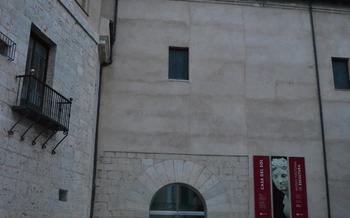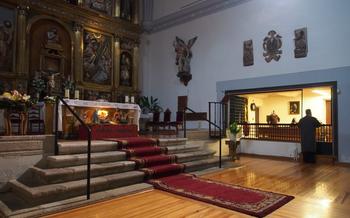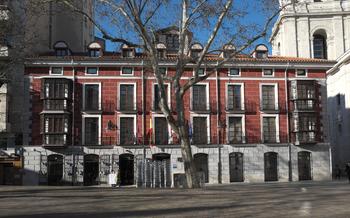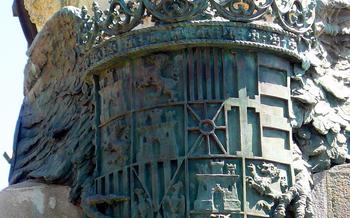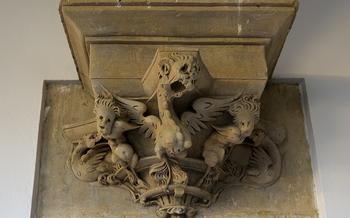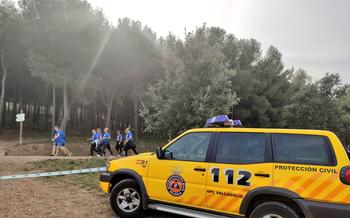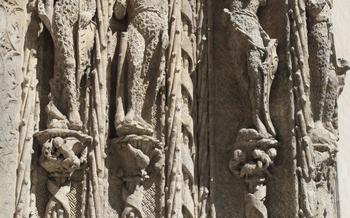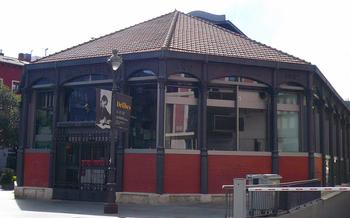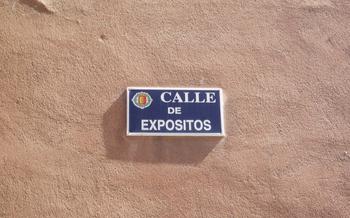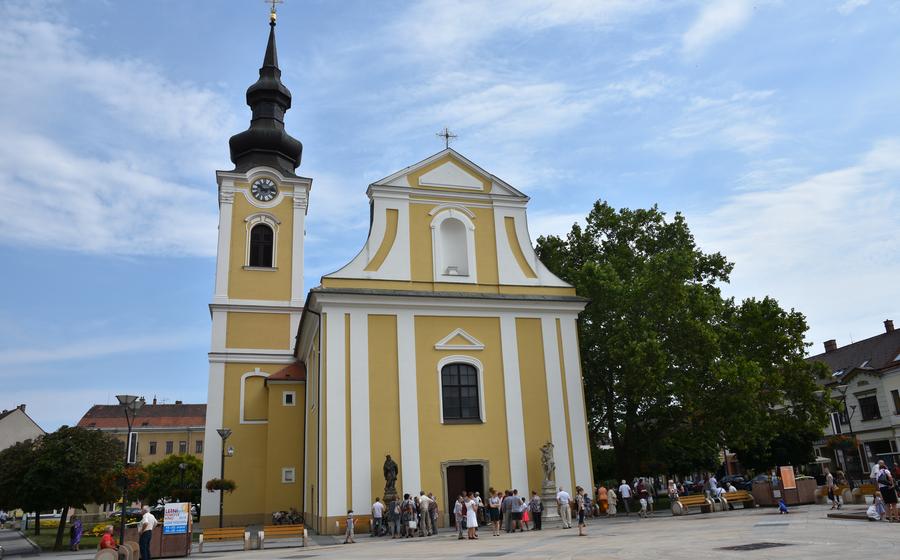
Iglesia de San Lorenzo
- Iglesia de San Lorenzo: A Monumental Treasure in Valladolid
- Exploring the Gothic Masterpiece
- Marveling at the Altarpiece
- Discovering Hidden Gems
- The Tower's Tale
- Religious Significance and Pilgrimage
- A Place of Worship and Community
- Echoes of the Past:
- Architectural Innovations and Techniques
- Symbolism and Iconography
- Artistic Treasures and Masterpieces
- Preserving a Legacy
- Visiting the Iglesia de San Lorenzo: Practical Information and Tips
- Insider Tip: Unraveling the Secret of the Hidden Crypt
Iglesia de San Lorenzo: A Monumental Treasure in Valladolid
In the heart Lorenzo. This awe-inspiring church, with its towering spires and intricate stone carvings, ranks among the city's most significant architectural landmarks. Its history is deeply entwined with the religious and cultural heritage of Valladolid, making it a must-visit destination for pilgrims, history buffs, and art enthusiasts alike.
Step inside the grand entrance, and you'll be greeted by a breathtaking spectacle of Gothic artistry. Soaring ribbed vaults, intricate stained glass windows, and a magnificent altarpiece create an atmosphere of reverence and wonder. The church's construction spanned several centuries, from the 13th to the 16th, resulting in a harmonious blend of architectural styles. Each era left its mark, adding to the church's rich tapestry of history and artistic expression.
Beyond its architectural splendor, the Iglesia de San Lorenzo is home to a wealth of notable artwork and religious relics. Among them, the revered image of the Virgin of San Lorenzo holds a special place in the hearts of the local faithful. According to legend, this miraculous statue was discovered by a shepherd and brought to the church, where it has been venerated for centuries.
Exploring the Gothic Masterpiece
The Iglesia de San Lorenzo stands as a testament to the intricate beauty of Gothic architecture, showcasing its defining features with remarkable precision. The church's pointed arches soar upwards, creating a sense of awe and grandeur. Every inch of the exterior is adorned with intricate carvings, depicting biblical scenes, mythical creatures, and symbolic motifs. The flying buttresses, essential for supporting the structure's weight, add a sense of dynamism and elegance to the building. The stained glass windows, with their vibrant hues and intricate designs, cast a kaleidoscope of colors onto the interior, creating a mystical and ethereal atmosphere.
Beyond its aesthetic appeal, the Gothic style of the Iglesia de San Lorenzo played a significant role in shaping Valladolid's architectural landscape. The church's grandeur and complexity set a new standard for religious architecture in the city, inspiring the construction of other Gothic masterpieces in the surrounding area. The influence of Gothic style can be seen in many of Valladolid's landmarks, including the Cathedral and the Colegio de San Gregorio, creating a harmonious and visually stunning cityscape.
Marveling at the Altarpiece
The altarpiece of the Iglesia de San Lorenzo is an awe-inspiring sight, capturing the attention of all who enter the church. This magnificent masterpiece serves as the focal point of the sacred space, radiating an air of reverence and devotion. Crafted by skilled artisans, the altarpiece is a testament to the artistry and craftsmanship that flourished during the Gothic period.
Intricate carvings adorn the altarpiece, depicting scenes from the Bible with remarkable detail and precision. Biblical figures, saints, and angels are brought to life through the expressive faces, flowing garments, and intricate details that characterize the carvings. The altarpiece's narrative unfolds in a series of panels, each telling a story from the life of Christ or the Virgin Mary.
Beyond its artistic beauty, the altarpiece holds profound symbolism and theological significance. Each element, from the central figures to the smallest decorative motif, carries a deeper meaning, inviting viewers to contemplate the mysteries of faith and the divine. The altarpiece serves as a visual representation of the church's teachings, guiding the faithful on a spiritual journey through its sacred imagery.
The creation of the altarpiece was a collaborative effort involving renowned artists of the era. Each artist brought their unique talents and perspectives to the project, resulting in a harmonious blend of styles and techniques. The altarpiece stands as a testament to the power of collaboration and the collective artistic vision that shaped this remarkable work of art.
Discovering Hidden Gems
Venturing beyond the main altar, the Iglesia de San Lorenzo reveals a treasure trove of hidden gems. Intricate chapels and side altars adorn the church's interior, each housing remarkable artworks, sculptures, and relics that tell their own unique stories. Explore the Chapel of the Holy Sacrament, where a stunning altarpiece depicts the Last Supper in intricate detail. Admire the delicate carvings and colorful paintings that adorn the Chapel of San Ildefonso, dedicated to the patron saint of the city. Discover the Chapel of Nuestra Señora de las Angustias, housing a poignant sculpture of the Virgin Mary in her moment of sorrow.
These hidden treasures are not merely decorative; they hold deep spiritual significance and are entwined with local legends and traditions. The image of the Virgin of the Anguish, for instance, is believed to have miraculous powers, attracting pilgrims from far and wide. The stories and legends surrounding these artworks contribute to the church's rich tapestry of history and faith, creating a palpable sense of spirituality that envelops visitors.
The Tower's Tale
The imposing tower of the Iglesia de San Lorenzo stands tall, its grandeur a testament to the church's significance. Soaring above the city, the tower is a symbol of the church's spiritual and architectural might. Constructed in the 16th century, it blends Gothic and Renaissance elements, showcasing the architectural evolution of the church. Its intricate carvings, delicate tracery, and intricate pinnacles create a harmonious blend of styles.
From the tower's vantage point, visitors are treated to breathtaking panoramic views of Valladolid. The city's historic center, with its maze of cobblestone streets and architectural gems, unfolds before their eyes. The rolling hills and distant mountains provide a picturesque backdrop, completing the awe-inspiring panorama.
The tower also holds historical significance, having served as a watchtower during medieval times. Its strategic location allowed for the early detection of approaching armies or potential threats. Its role in the city's defense further cements its importance as a symbol of strength and protection.
Today, the tower remains an integral part of the church, its imposing presence a beacon of faith and resilience. Whether admired from afar or experienced firsthand, the tower of the Iglesia de San Lorenzo is a captivating testament to the church's rich history and architectural prowess.
Religious Significance and Pilgrimage
The Iglesia de San Lorenzo holds immense religious significance as a pilgrimage site for devout Catholics. The church is dedicated to the Virgin of San Lorenzo, whose miraculous image is deeply revered by the local community. Believers flock to the church throughout the year, seeking solace, guidance, and blessings from the Virgin.
The annual pilgrimage to the church, held in September, is a spectacle to behold. Thousands of pilgrims from across the region converge in Valladolid to pay homage to the Virgin and participate in the festivities. The streets come alive with processions, music, and prayers as devotees carry the Virgin's image through the city.
During the pilgrimage, the church is adorned with colorful decorations, and the air is filled with a sense of devotion and reverence. Pilgrims light candles, offer prayers, and touch the Virgin's image, believing in its miraculous powers. The pilgrimage is not just a religious event but also a celebration of community and faith, bringing together believers from all walks of life.
The church's religious significance extends beyond the annual pilgrimage. Throughout the year, it serves as a place of worship and prayer for the local community. Masses are held regularly, and parishioners gather to celebrate religious festivals and milestones. The church's spiritual atmosphere and the devotion to the Virgin of San Lorenzo make it a cherished and sacred space for the people of Valladolid.
A Place of Worship and Community
The Iglesia de San Lorenzo serves as a spiritual haven and a focal point for the local community. It is a place where the faithful gather for worship, prayer, and religious ceremonies, fostering a sense of unity and belonging among parishioners. The church hosts a vibrant parish life, with regular masses, community events, and charitable initiatives that bring people together and strengthen the bonds within the community. The church's inviting atmosphere, stunning architecture, and rich history create a welcoming space for both locals and visitors to connect with their faith and find solace and inspiration within its walls.
Echoes of the Past:
The Iglesia de San Lorenzo has witnessed countless historical events and has played a significant role in shaping Valladolid's identity. Over the centuries, it has hosted royal visits, grand weddings, and solemn ceremonies within its sacred walls. Kings and queens, nobles, and commoners alike have graced its hallowed halls, leaving an indelible mark on the church's history.
One notable event that took place within the church was the wedding of King Alfonso X of Castile to Violant of Aragon in 128This royal union marked a significant milestone in the history of the city and the kingdom. The church also served as the venue for the Cortes of Castile, a legislative assembly, on several occasions, highlighting its importance as a center of political power.
Throughout the centuries, the church has been associated with various historical figures who have left their mark on Valladolid's history. One such figure is the renowned explorer Christopher Columbus, who visited the church in 1493 after his return from his first voyage to the Americas. The church also holds the tomb of Admiral Alonso de Fonseca, a prominent figure in the Spanish navy during the 15th century.
These historical events and associations have woven a rich tapestry of stories and legends that surround the Iglesia de San Lorenzo. Visitors to the church can almost feel the echoes of the past as they walk through its grand halls, imagining the footsteps of kings and queens, the whispers of courtiers, and the prayers of the faithful that have filled its sacred space for centuries.
Architectural Innovations and Techniques
The Iglesia de San Lorenzo showcases innovative construction techniques that were pivotal in the development of Gothic architecture in Spain. Ribbed vaults, flying buttresses, and stained glass windows are prominently featured, demonstrating the ingenuity of the architects and builders.
The ribbed vaults, with their intricate web-like patterns, not only enhance the aesthetic appeal of the interior but also distribute the weight of the ceiling more efficiently, allowing for larger and more open spaces.
Flying buttresses, with their graceful arches reaching out from the walls, provide additional support to the structure, enabling the construction of taller and more slender buildings. These buttresses not only serve a functional purpose but also add a distinctive visual element to the exterior of the church.
Stained glass windows, with their vibrant colors and intricate designs, transform the interior space, creating an ethereal and awe-inspiring atmosphere. The windows depict biblical scenes, saints, and allegorical figures, adding to the church's spiritual and artistic significance.
These innovative techniques not only contributed to the structural integrity and beauty of the Iglesia de San Lorenzo but also influenced the development of Gothic architecture throughout Spain, leaving a lasting legacy on the country's architectural heritage.
Symbolism and Iconography
The Iglesia de San Lorenzo is a treasure trove of symbolism and iconography, inviting visitors to delve deeper into its spiritual and theological meanings. Biblical scenes, saints, and allegorical figures adorn the church's interior, each carrying profound messages. The intricate carvings and paintings depict stories from the Bible, providing a visual narrative for the faithful. These symbols and motifs serve as a reminder of the church's role as a place of worship and contemplation, encouraging visitors to reflect on the deeper aspects of their faith.
Understanding the symbolism within the church enhances the visitor's experience, revealing hidden layers of meaning. For instance, the rose window above the main entrance symbolizes the Virgin Mary, representing her purity and heavenly glory. The gargoyles adorning the exterior of the church serve as a reminder of the battle between good and evil, while the intricate carvings on the capitals depict scenes from the lives of saints, inspiring devotion and admiration.
Exploring the symbolism of the Iglesia de San Lorenzo is a journey of discovery, inviting visitors to connect with the spiritual essence of the church and gain a deeper appreciation for its artistic and religious significance.
Artistic Treasures and Masterpieces
The Iglesia de San Lorenzo houses a remarkable collection of valuable artworks and masterpieces, testament to its enduring significance as a cultural treasure. Paintings, sculptures, and carvings by renowned Spanish artists adorn the church's interior, each piece contributing to its rich artistic tapestry.
Among the notable works is a stunning altarpiece, a masterpiece of Gothic art, intricately carved with biblical scenes and adorned with gold leaf. The altarpiece is a testament to the skill and artistry of the craftsmen who created it, and its grandeur is a focal point of the church's interior.
Visitors can also admire the church's collection of sculptures, which include works by the renowned sculptor Juan de Juni. Juni's sculptures are characterized by their realism and emotional depth, and they bring a sense of life and movement to the church's interior.
The church's paintings are equally impressive, showcasing the talents of Spanish masters such as Alonso Berruguete and Pedro Berruguete. Their works depict religious scenes and figures with vibrant colors and meticulous detail, creating a sense of awe and inspiration within the sacred space.
Exploring the artistic treasures of the Iglesia de San Lorenzo is a journey through the history of Spanish art, allowing visitors to appreciate the skill and devotion of the artists who contributed to its creation. These works of art are not merely decorative elements but integral parts of the church's spiritual and cultural heritage.
Preserving a Legacy
The Iglesia de San Lorenzo, with its centuries-old history and architectural significance, requires diligent preservation efforts to ensure its longevity. Over time, the church has undergone several restoration projects aimed at safeguarding its structural integrity and artistic splendor. These endeavors involve meticulous cleaning and repair of the stonework, restoration of intricate carvings and sculptures, and conservation of the vibrant stained glass windows. Experts in architecture, art history, and conservation collaborate to ensure that the church's original features are preserved while addressing the inevitable effects of aging and environmental factors.
One of the significant challenges in maintaining such a historic structure lies in balancing the need for preservation with the desire to retain its authentic character. Restoration projects aim to restore the church to its former glory while respecting its historical significance. This delicate balance requires careful assessment and decision-making to ensure that modern interventions do not compromise the church's original design and aesthetic.
The preservation of the Iglesia de San Lorenzo is not solely the responsibility of restoration experts but also involves the active participation of the community. Local residents, visitors, and religious organizations play a vital role in supporting conservation initiatives. Through donations, volunteering, and advocacy, the community demonstrates its commitment to preserving this iconic landmark for future generations.
Visiting the Iglesia de San Lorenzo: Practical Information and Tips
Practical Information: The Iglesia de San Lorenzo is open to visitors from Tuesday to Sunday, with varying hours depending on the season. Admission fees are minimal, and guided tours are available upon request. The church is wheelchair accessible, and restrooms are available on-site.
Tips for Visitors: To fully appreciate the church's intricate details, plan your visit during daylight hours when the natural light illuminates the stained glass windows. Allocate at least an hour to explore the church's interior and exterior, taking time to admire the architectural elements, artwork, and chapels. For a more immersive experience, join a guided tour led by knowledgeable experts who can share insights into the church's history and significance.
Combining Attractions: After visiting the Iglesia de San Lorenzo, take advantage of the opportunity to explore other nearby attractions in Valladolid. The Plaza Mayor, a historic square, is just a short walk away and offers a glimpse into the city's vibrant atmosphere. For art enthusiasts, the Museo Nacional de Escultura, located in a former convent, houses an impressive collection of religious sculptures. Complete your visit with a culinary experience at one of the many traditional restaurants in the city center, savoring the local cuisine and immersing yourself in Valladolid's rich cultural heritage.
Insider Tip: Unraveling the Secret of the Hidden Crypt
One of the most intriguing hidden gems within the Iglesia de San Lorenzo is the crypt, which lies beneath the main altar. This subterranean chamber is a sacred space that holds the remains of several prominent figures from Valladolid's history. While it is not always open to the public, visitors who are fortunate enough to gain access will be rewarded with a glimpse into the city's rich past.
The crypt exudes an atmosphere of mystery and reverence, with its dimly lit corridors and ancient stone walls. Visitors can marvel at the ornate sarcophagi and tombs that line the chamber, each one telling a story of a life once lived. Among the most notable figures buried here are members of the powerful Enríquez family, who played a significant role in shaping the city's destiny.
Exploring the crypt offers a unique perspective on the church's history and the lives of those who have contributed to Valladolid's cultural and spiritual heritage. It is a place where the past comes alive, providing visitors with a deeper understanding of the city's enduring legacy.
